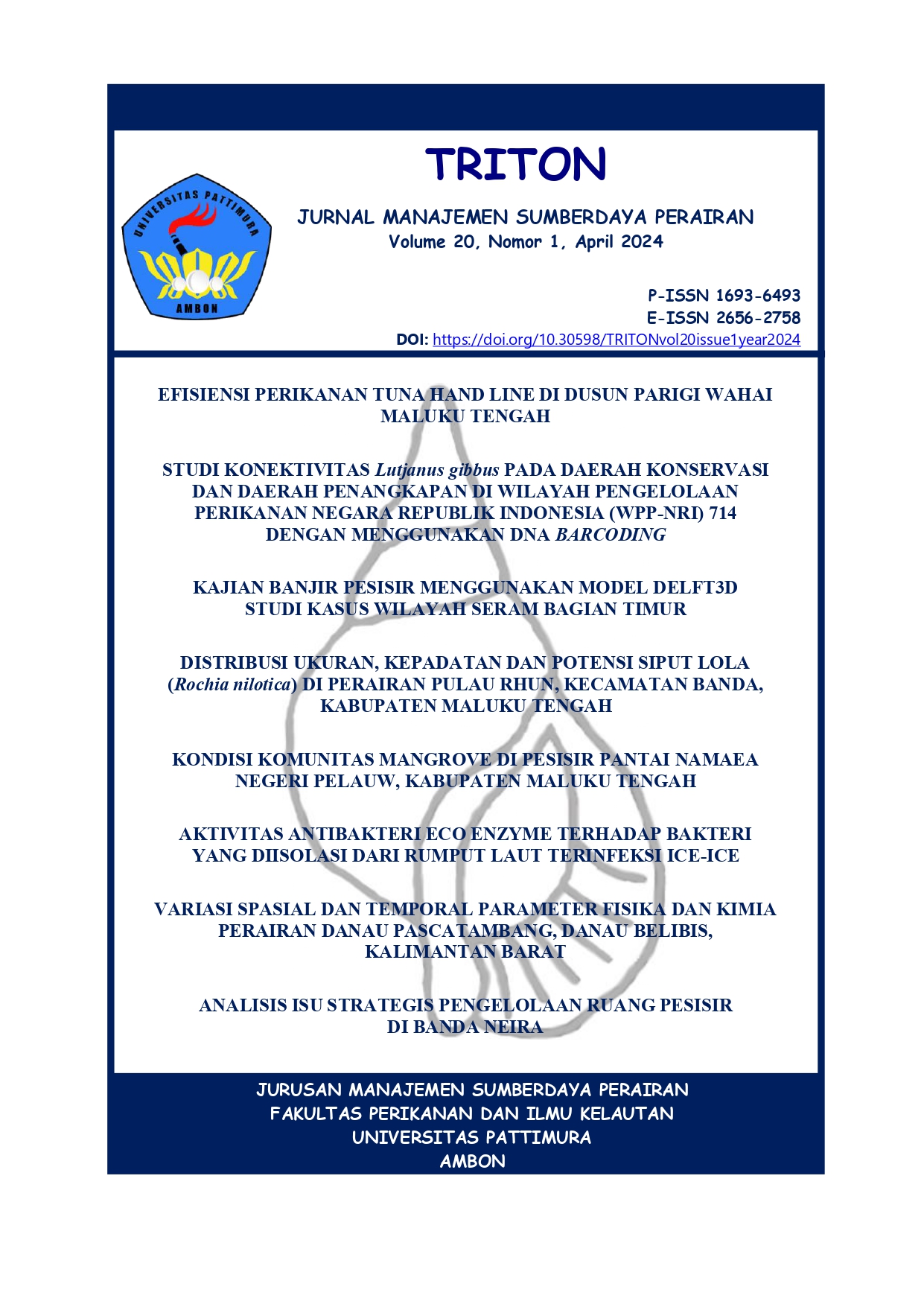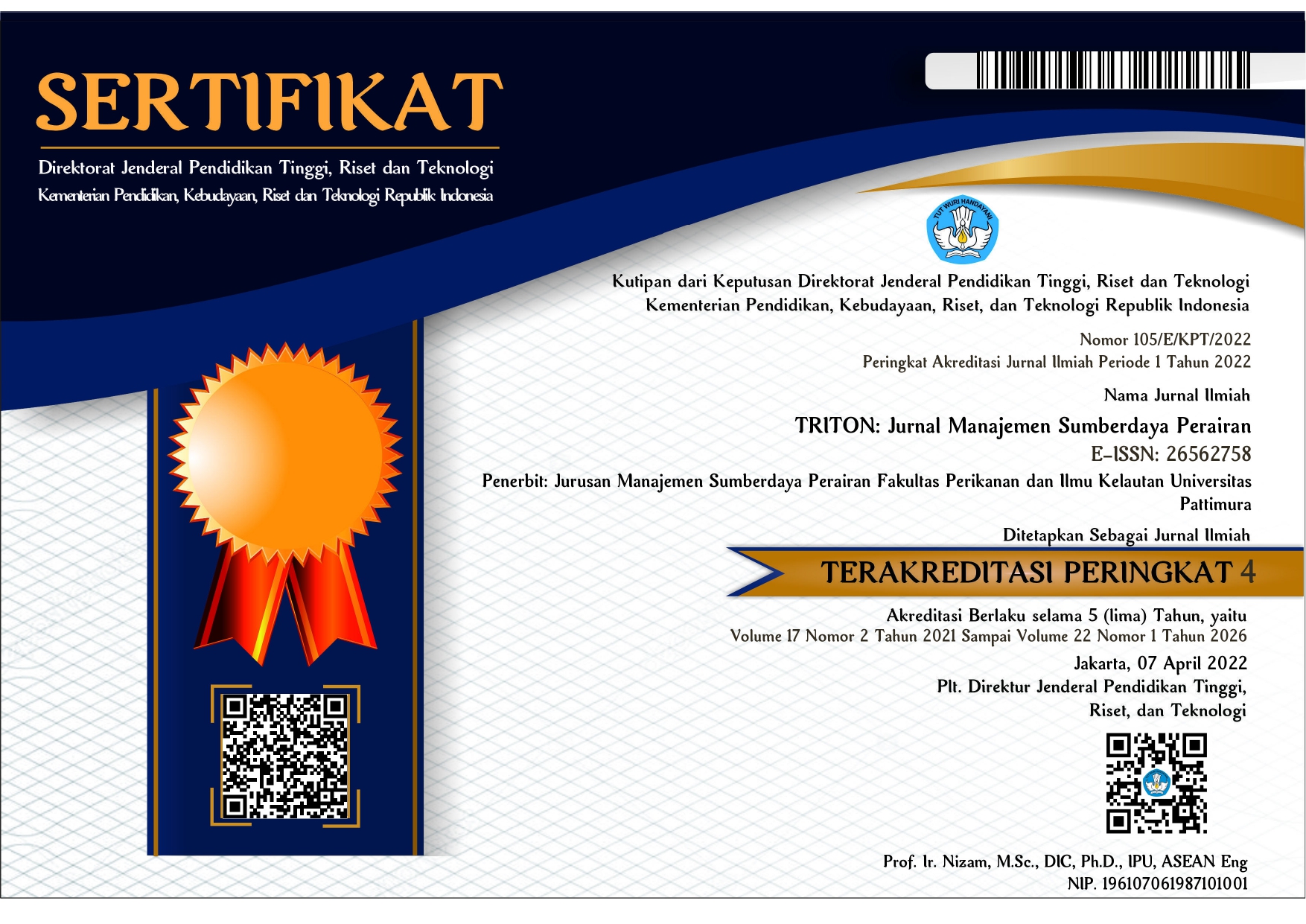DISTRIBUSI UKURAN, KEPADATAN DAN POTENSI SIPUT LOLA (Rochia nilotica) DI PERAIRAN PULAU RHUN, KECAMATAN BANDA, KABUPATEN MALUKU TENGAH
Abstract
Lola snail (Rochia nilotica) are marine biological resources that have important economic value, but their production tends to decrease from year to year. Research to assess the size distribution, density and potential of lola snail (R. nilotica) was carried out in the waters of Rhun Island, Banda District, Central Maluku Regency from September – December 2020. Sampling was carried out in three zones, namely the seagrass zone, flat reef and edge reef using a quadratic linear transect placed parallel to the coastline. A total of 350 quadrants measuring 5 x 5 m were placed on the transect line for each zone. Each individual found in the quadrant had its diameter measured and weighed and then returned to its original place. During the research, 372 individual lola snail (R. nilotica) were found with a diameter size range of 11.6 – 118.9 mm ( = 60.98 mm) and a weight size range of 4.78 – 449.92 g ( = 171.69 g) where the largest size is owned by individuals in the edge reef zone while the smallest size is found in the seagrass zone. The highest density is in the edge reef zone and the lowest is in the seagrass zone. Based on the number of individuals, the highest potential for lola snail (R. nilotica) is in the flat reef zone and the lowest potential is in the edge reef zone. On the other hand, based on biomass, the lola snail (R. nilotica) has the greatest potential in the edge reef area, while the smallest potential is in the seagrass zone. Based on legal standards diameter, only lola snail in the edge reef zone may be exploited with a sustainable potential of 467 individuals (148.45 kg) with a total allowable catch of 374 individuals (118.76 kg).
ABSTRAK
Siput lola (Rochia nilotica) merupakan sumberdaya hayati laut yang bernilai ekonomis penting namun produksinya cendeRhung menuRhun dari tahun ke tahun. Penelitian untuk mengkaji distribusi ukuran, kepadatan dan potensi siput lola (R. nilotica) dilakukan di perairan Pulau Rhun, Kecamatan Banda, Kabupaten Maluku Tengah dari bulan September – Desember 2020. Pengambilan sampel dilakukan pada tiga zona yaitu zona lamun, flat reef dan edge reef dengan menggunakan transek linear kuadrat yang diletakan sejajar garis Pantai. Sebanyak 350 kuadran berukuran 5 x 5 m diletakan pada transek untuk masing-masing zona. Setiap individu yang ditemukan dalam kuadran diukur diameternya dan ditimbang beratnya kemudian dikembalikan ke tempat asalnya. Selama penelitian ditemukan 372 individu siput lola (R. nilotica) dengan kisaran ukuran diameter 11,6 – 118,9 mm ( = 60,98 mm) dan kisaran ukuran berat 4,78 – 449,92 g ( = 171,69 g) dimana ukuran terbesar dimiliki oleh individu di zona edge reef sedangkan ukuran terkecil ditemukan pada zona lamun. Kepadatan tertinggi terdapat pada zona edge reef dan terendah terdapat pada zona lamun. Berdasarkan jumlah individu, potensi tertinggi siput lola (R. nilotica) berada pada zona flat reef dan potensi terendah berada pada zona edge reef. Sebaliknya, berdasarkan biomassa potensi terbesar dimiliki oleh siput lola (R. nilotica) pada daerah edge reef sedangkan potensi terkecil pada zona lamun. Berdasarkan ukuran legal, hanya siput lola pada zona edge reef yang boleh dieksploitasi dengan potensi lestari sebesar 467 individu (148,45 kg) dengan jumlah tangkapan yang diperbolehkan sebesar 374 individu (118,76 kg).
Kata Kunci: Siput lola, distribusi ukuran, kepadatan, potensi, Pulau Rhun
Downloads
References
Abukena, S. L. (2014). Kemampuan Pulih Sebagai Dasar Pengelolaan Sumber Daya Trochus niloticus di Perairan Pulau Rhun Kecamatan Banda Naira Kabupaten Maluku Tengah. Disertasi Sekolah Pascasarjana Institut Pertanian Bogor, Bogor.
Abukena, S, L., Wardianto, Y., Setyobudiandi, I. & Khow, S. A. (2014). Pertumbuhan siput lola (Trochus niloticus L. 1767) di perairan kepulauan Banda Naira Kabupaten Maluku Tengah. Jurnal Biologi Indonesia, 10(2), 307-313.
Achyani, R. (2011). Trochus sp: Pendekatan ekologi dan biologi. Jurnal Harpodon Borneo, 4(2), 12 – 20.
Anonimous. (2017). Keputusan Menteri Kelautan dan Perikanan Republik Indonesia nomor 50/Kepmen-KP/2017 tentang Estimasi Potensi, Jumlah Tangkapan yang Diperbolehkan, dan Tingkat Pemanfaatan Ikan di Wilayah Pengelolaan Perikanan Negara Republik Indonesia. 8 p
Arifin, Z. (1993). Sebaran geografis, habitat dan perikanan lola (Trochus niloticus) di Maluku. Perairan Maluku dan Sekitarnya. Balai Litbang Sumberdaya Laut, Puslitbang Oseanologi-LIPI, Ambon. p 93 - 101
Braley, R. (1993). Trochus niloticus (Siput lola) production in Maluku Province, Eastern Indonesia. SPC Trochus Information Bulletin, 2, 4-9.
Dolorosa, R. G., Songco, A. M., Calderon, V., Magbanua, R. & and Matillano, J. A. (2010). Population structure and abundance of Trochus niloticus in Tubbataha Reefs Natural Park, Palawan, Philippines with notes on poaching effects. SPC Trochus Information Bulletin, 15, 17-23.
English, S., Wilkinson, C. & Baker, V. (1997). Survey Manual for Tropical Marine Resources. Edition 2, Australian Institute of Marine Sciences, Townsville, North Queensland, Australia, 390 pp.
Gaspersz, E. J. & Saiya H. G. (2018). Pemetaan kearifan lokal budaya sasi di negeri Haruku dan negeri Kailolo, pulau Haruku, Kabupaten Maluku Tengah. Seminar Nasional Geomatika: Penggunaan dan Pengembangan Produk Informasi Geospasial Mendukung Daya Saing Nasional p 107-116. https://doi.org/10.24895/SNG.2018.3-0.933.
Gillet, R., McCoy, M., Bertram, I., Kinch, J. & Desurmont, A. (2020). Trochus in the Pacific Islands: A review of the fisheries, management and trade. Pacific Community. Noumea, New Caledonia.
Krebs, C. J. (1985). Ecology: the experimental analysis of distribution and abundance. 3rd edition, Harper & Row Publishers, New York, 800 pp.
Leimena H. E. P., Syamsudin, S. & Subahar T. S. (2006). Potensi Reproduksi Keong Lola (Trochus niloticus) di Pulau Saparua, Maluku Tengah. Hayati, 13(2), 49–52.
Leimena, H. E. P., Subahar, T. S. & Adianto, A. (2007). Kepadatan, biomassa, dan pola distribusi keong lola (Trochus niloticus) di Pulau Saparua, Kabupaten Maluku Tengah. Berkala Penelitian Hayati, 13, 73–78.
Persada, N. P., Mangunjaya, F..M. & Tobing, I. S. (2018). Sasi sebagai budaya konservasi sumberdaya alam di kepulauan Maluku. Jurnal Ilmu dan Budaya, 41(59), 6869–6900.
Purcell. S., Tiitii, S., Aiafi, J., Tone, A., Tony, A., Lesa, M., Esau, C., Cullis, B., Gogel, B., Seinor, K., Ceccarelli, D. & Tagliafico, A. (2019). Ecological and socioeconomic impacts of trochus introductions to Samoa - A project of the Australian Centre for International Agricultural Research. Noumea, New Caledonia: Pacific Community. SPC Fish Newsl, 160, 36-40.
Purcell, S. W. & Ceccarelli, D. M. (2020). Population colonization of introduced trochus (Gastropoda) on Coral Reef in Samoa. Ecol. Restor, 29(1), 1-12. https://doi.org/10.1111/rec.13312.
Purcell, S.W., Tagliafico, A., Cullis, B. R. & Gogel, B. J. (2021). Socioeconomic impacts of resource diversification from small-scale fishery development. Ecol Soc, 26(1), 14. https://doi.org/10.5751/ES-12183-260114.
Saiya, H. & Heij, C. (2017). Kearifan Lokal Masyarakat Adat untuk Konservasi BuRhung Gosong Maluku (Eulipoa wallacei). Prosiding Seminar Nasional & CFP I IDRI: Sinergitas Unsur Pentaheliks Bagi Pengembangan Sumberdaya Manusia. p 17-25. lSSN: 2598:7577
Satria, A. & Mony, A. (2019). Dinamika Praktek Sasi Laut di tengah Transformasi Ekonomi dan Politik Lokal. Sodality: Jurnal Sosiologi Pedesaan, 7(2), 143-152
Seinor, K.M., Smith, S. D. A., Logan, M. & Purcell, S. W. (2020). Biophysical habitat features explain colonization and size distribution of introduced trochus (Gastopoda). Front Mar Sci, 7(223), 1-12. https://doi.org/10.3389/fmars.2020.00223.
Tuhumury, F. S. (2011). Analisis aspek bioekologi, sosekbud, hukum dan kelembagaan dalam pengelolaan sumberdaya siput lola (Trochus niloticus, Linn) di pesisir pulau Saparua, Kecamatan Saparua, Kabupaten Maluku Tengah Provinsi Maluku. Disertasi. Universitas Diponegoro, Semarang.
Tuhumury, S. F. (2013). Population structure and habitat condition of lola snail (Trochus niloticus. Linn) at East coast, Saparua Island, Saparua Subdistrict, Central Maluku District. Journal of Environment and Ecology, 4(1), 97-110.
Ulm, S., McNiven, I. J., Aird, S. J. & Lambrides, A. B. J. (2021). Sustainable harvesting of Conomurex luhuanus and Rochia niolotica by Indigenous Australians on the Great Barrier Reef over the past 2000 years. Journal of Archeological Science, 28, 1–40. https://doi.org/10.1016/j.jasrep.2019.102017
Utami, R.T., Ibrahim, P.S., Kusnadi, A., Kurnianto, D., Triandiza, T. & Pesillette, R.N. (2022). Hubungan panjang berat dan faktor kondisi siput lola (Rochia nilotica) di perairan Maluku, Sumbawa, dan Bengkulu. Jurnal Kelautan Tropis, 25(3), 320-328
Wahyudi, N. D., Hidayati, D., Arbi, U. Y. & Ismail, A. (2023). Morphometric study of lola Rochia nilotica (Linnaeus 1767) shells from natural harvest found in Indonesian. Biodiversitas, 24, 4711–4722. https://doi.org/10.13057/biodiv/d240911
Copyright (c) 2024 Laura Siahainenia, Rustamin M Lamuhamad, Alex S W Retraubun, Debby A J Selanno, Jesaja A Pattikawa

This work is licensed under a Creative Commons Attribution-NonCommercial-ShareAlike 4.0 International License.


1.png)










